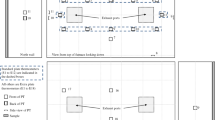Abstract
A segment of the on-going research program on fire spread via exterior walls conducted at the Institute for Research in Construction of the National Research Council of Canada is described. The research includes full-scale experimental studies of fire exposure to exterior walls, fire hazards associated with the use of combustible materials, and the development of new test methods for assessing the flammability of combustible cladding. Correlations between the results of a new full-scale test and standard flame spread tests (Steiner tunnel test, radiant panel test, roof deck test) were investigated. A prototype of a reduced-scale test, the vertical channel test, is described. It was found that, at present, the full-scale test is the most appropriate method to evaluate the fire hazards of combustible wall assemblies.
Similar content being viewed by others
References
MacDiarmid, H., “Report on the Fire Commissioner's Inquiry into the fire at 230 Fairlane Avenue, Winnipeg, Manitoba, on May 20, 1980.”
The Corporation of the Township of Richmond, BC, private communication (letter to NRCC, dated July 28, 1983, describing the fire at 8291 Bennett Road, on April 23, 1983.)
Yokoi, S., “Study on the Prevention of Fire Spread Caused by Hot Upward Current,” Building Research Institute, Report No. 34, Tokyo, Japan, 1960.
Fisher, Fl. L. and Williamson, R. B., “A Summary Description of the Modified ASTM E-108 Test Procedure,” Fire Research Group, Report No. 78-13, University of California, Berkeley, CA, December 1978.
Martin, S. B. and McKee, R. G., “Fire Tests for Exterior Wall Materials: Fire Transmission Over Building Facades,” SRI International, Final Report Project PYU 6935, Menlo Park, CA, 1980.
Ondrus, J. and Petterson, O., “Fire Hazards of Facades with Externally Applied Additional Insulation,” Report LUTVDG/TVBB-3025, Lund Institute of Technology, Lund, Sweden, 1986.
Beitel, J. J. and Evans, W. R., “Multi-Story Fire Evaluation Program, Final Report, Volume I: Text: SWRI Project No. 01-6112,” Department of Fire Technology, Southwest Research Institute, November 1980.
Raes, H., “The Role that Facades Play in Fire Spread — 1,”Fire International,59, pp. 18–28, 1978.
Bechtold, R., “The Role that Facades Play in Fire Spread — 2,”Fire International,59, pp. 32–40, 1978.
ASTM E 5.11, Task Group 1, White Paper: “Assessing The Fire Performance Characteristics of Exterior Walls,” 1989.
Heselden, A. J. M., “Parameters Determining the Severity of Fire,” Paper in Joint Fire Research Organization Symposium No. 2, Behavior of Structural Steel in Fire, HMSO, London, 1968.
Harmathy, T. Z., “Flame Deflectors,” Building Research Note No. 96, Division of Building Research, National Research Council, Ottawa, Canada, October 1974.
IMO Resolution A.516(14), “Recommendation on the Fire Test Procedures for Surface Flammability of Bulkhead and Deck Finish Materials (1985).”
Author information
Authors and Affiliations
Rights and permissions
About this article
Cite this article
Oleszkiewicz, I. Fire exposure to exterior walls and flame spread on combustible cladding. Fire Technol 26, 357–375 (1990). https://doi.org/10.1007/BF01293079
Issue Date:
DOI: https://doi.org/10.1007/BF01293079




